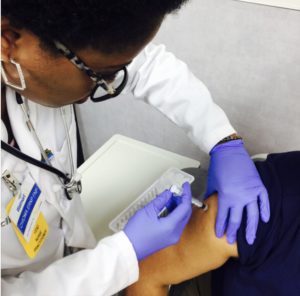The Future Generation of Retail Health Care in the USA
Walmart Care Clinics are full-service clinics, providing full, accessible and affordable primary care right where people need in it – in retail centres. In the United States, 140 million people visit a Walmart every week so the conveniently located care clinics provide easy access to non-urgent health care concerns on a walk-in basis. The clinics have multiple examination rooms and provide full service labs by point of care testing or send out testing.
Located in rural Health Professional Shortage (HPSA) areas, Walmart Care Clinics provide primary care to the communities they serve. Sixty-three percent of the clinics are located in the Appalachian area or other HPSA [1]. Many of the patients are uninsured or underinsured and the cost of care in the clinics is affordable to most. These Nurse Practitioner (NP) led clinics also provide high quality primary care to those marginalized by society.
Andrew (not his real) name is one example. He came to the Retail Care Clinic with his son and handed the Nurse Practitioner a form, saying that they had already been turned away from four other facilities. He was requesting a physical in order for his son to enter a year-long drug rehabilitation programme, but was very concerned his son would not be able to get the help he needed because of the first question on the form: “Is the patient HIV positive?”. The NP evaluated the patient, obtained appropriate testing, and cleared him for admission to the programme. She then contacted the rehabilitation facility and told them if others were having difficulty accessing care she would be glad to see and care for them all. The facility was grateful as receiving evaluation and health care for the clients is a constant barrier to the individuals in need.

The Retail Care Clinics also helped Brian (not his real name) access the care he needed. With a history of Type 2 diabetes, hypertension and hyperlipidaemia, Brian had not taken any medication for the past six months, as he did not have a primary care provider. He lived in a very rural area and could not take time off work to travel over 100 miles for a medical appointment. The Retail Clinic was local, had extended and weekend hours and could provide him with primary care. It took several months, but his chronic illnesses were brought under control.
It is important that increased access to primary care be accompanied by improved efficacy and high-quality care. Walmart Care Clinics NPs practice evidence-based care in collaboration with physicians, pharmacists and other health care providers. A systematic review of NP outcomes shows similar outcomes to physician-only provided care. Care provided with collaboration between NPs and physicians reflects even better outcomes [2]. NP clinics are crucial in providing care to those who otherwise may not have care.
Retail clinics and urgent care centres can be cost-effective and time-saving alternatives to hospital emergency departments (EDs) for nonemergency care. It is estimated that 13.7%–27.1% percent of all ED visits could take place at a retail clinic or urgent care centre, with potential cost savings to the health care system of approximately US$ 4.4 billion annually [3].
With retail clinics’ low per-visit cost ($79) compared to the cost of a physician office visit ($160–$230), the total savings across all diabetes patients covered by commercial, Medicare, or Medicaid insurance could total over $100 million ($7 per person per year) under conservative assumptions and as high as $2.7 billion ($164 per person per year) if half of diabetes-related office visits migrated to retail clinics [4].
- Health Resources &Services Administration. HRSA Database. 2017 [cited 2017 1 November]; Available from: https://datawarehouse.hrsa.gov/tools/analyzers/hpsafind.aspx.
- Newhouse, R.P., et al., Advanced practice nurse outcomes 1990-2008: a systematic review. Nurs Econ, 2011. 29(5): p. 230-50; quiz 251.
- Weinick, R.M., R.M. Burns, and A. Mehrotra, Many emergency department visits could be managed at urgent care centers and retail clinics. Health Aff (Millwood), 2010. 29(9): p. 1630-6.
- Copeland, B., et al. Beyond the acute episode: Can retail clinics create value in chronic care? 2016 [cited 2017 1 November]; Available from: https://dupress.deloitte.com/dup-us-en/industry/health-care/retail-clinics-chronic-care-management.html.

